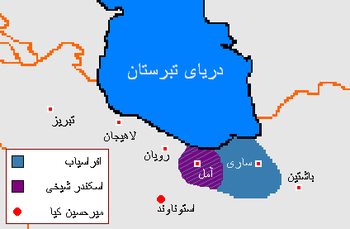آل أفراسياب (مازندران)
آل أفراسياب چلاویان | |||||||||||
|---|---|---|---|---|---|---|---|---|---|---|---|
| 1349–1504 | |||||||||||
 | |||||||||||
| العاصمة | آمل (1349–1359 & 1393-1403) فيروزكوه (؟) (1403–1504) | ||||||||||
| اللغات المشتركة | مازندراني | ||||||||||
| الدين | الإسلام الشيعي | ||||||||||
| الحكومة | ملكية | ||||||||||
• 1349–1359 | كيا أفراسياب (الأول) | ||||||||||
• ?–1504 | كيا حسين الثاني (الأخير) | ||||||||||
| الحقبة التاريخية | العصور الوسطى | ||||||||||
• تأسست | 1349 | ||||||||||
• الفتح الصفوي | 1504 | ||||||||||
| |||||||||||
جزء من سلسلة عن |
|---|
| تاريخ إيران |
 |
|
خط زمني |
أفراسـِياب أو آل چـَلاوي Chalavi كانت أسرة حاكمة إيرانية شيعية صغيرة في مازندران وازدهرت في أواخر العصور الوسطى، قبل العصر الصفوي؛ وتُسمى أيضاً آل كيا. وقد أسسها كيا أفراسياب، الذي هزم مملكة باوند في 1349 وجعل نفسه ملكاً على المنطقة. وفي 1504، غزا إسماعيل الأول مازندران وأنهى حكم أفراسياب للمنطقة.
التاريخ
كيا أفراسياب كان ابن شخص يُدعى حسن چلابي، الذي ينحدر من آل چلابي، العائلة المرموقة في مازندران والتي خدمت آل باوند. كان أفراسياب sipahsalar and the brother-in-law of the Bavandid ruler حسن الثاني (r. 1334-1349).
In 1349, the Bavandid ruler Hasan ordered the execution of one of his most powerful officials, Jalal ibn Ahmad Jal, who was from the powerful Jalali which governed Sari. The execution resulted in a revolt by the nobles of Mazandaran. Hasan then tried to get support from the Chulabids. However, the two sons of Afrasiyab, murdered Hasan while the latter was in a bath.
Afrasiyab then gained control of the Bavandid territories, thus marking the end of the Bavand dynasty and the start of the Afrasiyab dynasty. A son of Hasan managed to flee to the court of the Paduspanid ruler اسكندر الثاني, who later tried to restore Bavand rule in Mazandaran, but failed to do so. Afrasiyab also faced another problem; أعيان مازندران لم يعترفوا بحكمه ورأوه غاصباً.[1]
Afrasiyab shortly tried to achieve stability by asking aid from Mir-i Buzurg, a درويش سيد من دابودشت. However, some of Mir-i Buzurg's dervishes acted hostile to Afrasiyab, which made him imprison Mir-i Buzurg and many of his dervishes. However, the supporters of Mir-i Buzurg shortly revolted, and freed him from prison. In 1359, a battle between Afrasiyab and مير بزرگ took place near آمل, where Afrasiyab was defeated and was killed together with his three sons.
مير بزرگ shortly conquered the territories of the Afrasiyab dynasty, and laid foundations to the آل مرعش. Afrasiyab had several other sons who tried to restore Afrasiyabid authority in Mazandaran. ابنه فخر الدين چلابي اغتال أحد أبناء مير بزرگ، مما أدى إلى مذبحة لمعظم آل أفراسياب. Afrasiyab's other son اسكندر شيخي, managed with the aid of Timur, to restore Afrasiyabid authority in 1393.[1] Iskandar later aided Timur in his campaign إلى العراق و شيروان و الأناضول. After having achieved great success during the campaign, Iskandar was allowed to return to Mazandaran, but shortly rebelled against Timur. In 1403, Timur invaded Mazandaran to repress the rebellion. Iskandar, together with his wife and two children, then fled from Amol. Iskandar, fearing that they might betray him, killed them.[1]
Iskandar was shortly killed by the army of Timur, who under the orders of Timur, had Iskandar's head sent to his son كيا حسين الأول، الذي حصّن نفسه في فيروزكوه. كيا حسين الأول، after having seen the head of his father, agreed to surrender to Timur, and was pardoned by the latter, who acknowledged him as the ruler of the Afrasiyab dynasty. Kiya Husayn was later succeeded by his son Luhrasp, who ruled sometime around 1475. His grandson, Kiya Husayn II, ruled over a large part of western Mazandaran, and districts of Firuzkuh, Damavand, and Hari-rud. During the dissolution of the Aq Qoyunlu confederation, Kiya Husayn II expanded his rule from western into central Iran, where he captured Ray and Semman. He also defeated Mohammad Hosayn Mirza, who was the Timurid governor of Astarabad.[1]
He later became the enemy of the Safavid shah Ismail I (r. 1501-1524), whom he may have seen as a rival for the command over the Shi'ites in Iran. In 1504, Kiya Husayn II's territories was invaded by Ismail I, who seized the strongholds of Gol-e Khan and Firuzkuh, and surrounded Kiya Husayn II in Osta, who was shortly captured. However, the latter commmited suicide—his body was burned at Isfahan in front its inhabitants, whilst his followers in Mazandaran were slaughtered.[1]
المراجع
المصادر
- Madelung, W. (1984). "ĀL-E BĀVAND (BAVANDIDS)". Encyclopaedia Iranica, Vol. I, Fasc. 7. London u.a.: Routledge & Kegan Paul. pp. 747–753. ISBN 90-04-08114-3.
{{cite encyclopedia}}: Invalid|ref=harv(help) - Bosworth, C. E. (1984). "ĀL-E AFRĀSĪĀB". Archived copy. Encyclopaedia Iranica, Vol. I, Fasc. 7. London u.a.: Routledge & Kegan Paul. pp. 742–743. Archived from the original on 2014-02-20. Retrieved 2013-10-25.
{{cite encyclopedia}}: Invalid|ref=harv(help)CS1 maint: archived copy as title (link) - Savory, Roger (1998). "ESMĀʿĪL I ṢAFAWĪ". Encyclopaedia Iranica, Vol. VIII, Fasc. 6. pp. 628–636.
{{cite encyclopedia}}: Invalid|ref=harv(help)